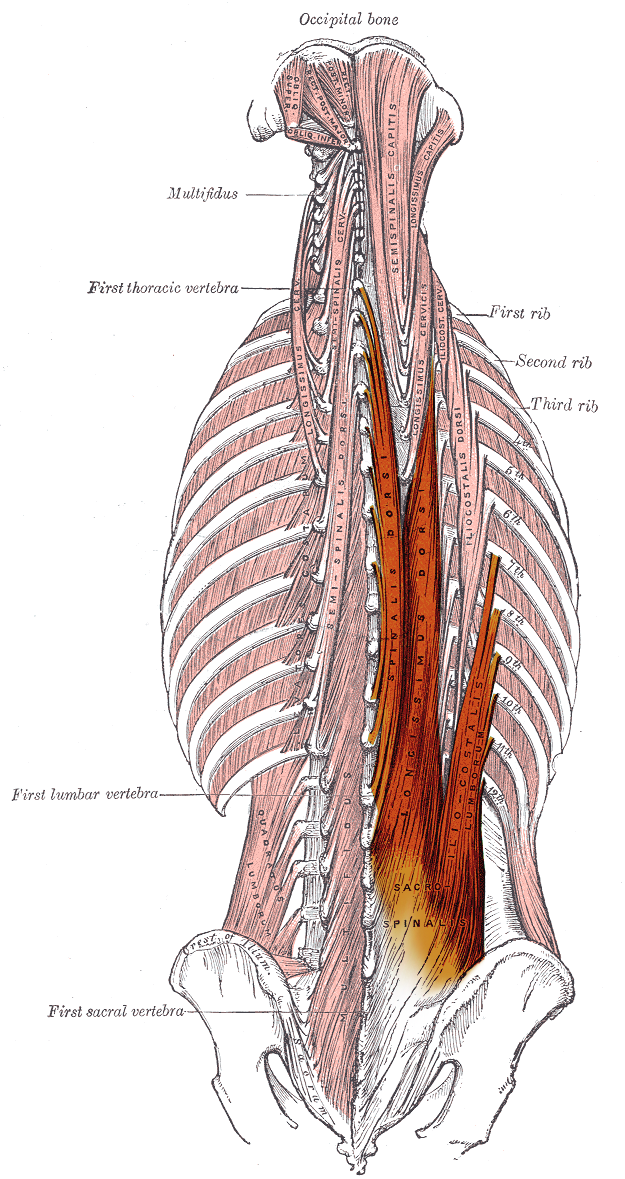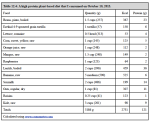The Best Lower Back Exercise
What's the best lower back exercise?
Many people do hyperextensions or deadlifts in hopes of strengthening their lower back muscles, the spinal erectors. Unfortunately, these exercises do not train the spinal erectors directly or through a full range of motion. There is a better and safer way to develop your spinal erectors.
The Spinal Erectors
|
The spinal erectors originate on the spinous processes of the thoracic vertebrae T9-T12, and the medial slope of the dorsal segment of the iliac crest. They insert on the spinous processes of the thoracic vertebrae T1 and T2 and the cervical vertebrae. The spinal erectors extend the spine i.e. arch the back. The lumbar spine range of motion differs between men and women. In men, the accumulative (flexion + extension) lumbar spine range of motion is 63°-83°. In women it is 48°-68°. The best lower back exercise will allow training of this full range of motion. In most people, the lumbar extensors are composed predominantly of slow twitch, endurance-tolerant fibers.1, 2 Therefore you should train them with slow movement, lighter loads, higher repetitions and a time under load of about 90 seconds, for greater safety and hypertrophy. |
 Spinal Erectors Image Source: Gray's Anatomy via Wikipedia |
Not Hyperextensions Nor Deadlifts
When one performs hyperextensions on the floor or a bench, the body moves primarily around the hips, not through spinal extension, and the prime movers are the hip extensors, the gluteus and the hamstrings. At most, the spinal erectors are synergists.
When one performs any type of deadlift, again, the body moves around the hips and the prime movers are the hip extensors. It is generally advised that during deadlifts the spine is held isometrically in a neutral position, so that no movement occurs in the lumbar spine.
The best lower back exercise should isolate and involve a full range of motion for the spinal erectors, and allow safe and progressive loading.
There exist purpose-built machines that accomplish this, such as the MedX lumbar machine. However, this machine is very expensive and takes up a lot of space.
Some say it is impossible to isolate the lower back muscles without such a machine. I disagree. You can perform the best lower back exercise in your own home with an exercise bench, a low platform, and a barbell.
The Best Lower Back Exercise
In this video, I demonstrate how to perform the best lower back exercise – isolated lumbar extensions – using conventional equipment.
These are important performance tips:
1. Place a platform or mats about 5-6" high about 18-24" away from and perpendicular to a standard exercise bench (about 17-20" in height).
2. Place a light barbell between the bench and the platform, parallel to the platform and perpendicular to the bench.
NOTE: Start with a light weight. As already noted above, in most people, and especially women, the lumbar extensors are composed predominantly of slow twitch, endurance-tolerant fibers.1, 2 Therefore you should train them with slow movement, lighter loads, higher repetitions and a time under load of about 90 seconds, for greater safety and hypertrophy.
3. Sit on the end of the bench facing the platform or mats, and place your feet on the platform or mats with your knees extended to about 135° in front of you. This posture makes it difficult or impossible to use your powerful hips or hamstrings as prime movers.
4. Bend forward to grasp the barbell.
5. Using only your spinal erectors, smoothly and slowly extend your spine. As demonstrated in the video, DO NOT ALLOW YOURSELF TO MOVE AT/AROUND THE HIPS.
6. At full extension, pause 1-5 seconds. Release and slowly return to the flexed position.
7. Ease into the flexed position, pause briefly, then ease out of the flexed position and reverse the motion.
8. Continue for 12-20 repetitions or about 90 seconds of time under load.
Notes
1. MANNION AF, DUMAS GA, COOPER RG, ESPINOSA FJ, FARIS MW, STEVENSON JM. Muscle fibre size and type distribution in thoracic and lumbar regions of erector spinae in healthy subjects without low back pain: normal values and sex differences. Journal of Anatomy. 1997;190(Pt 4):505-513. doi:10.1046/j.1469-7580.1997.19040505.x.
2. Thorstensson A, Carlson H. Fibre types in human lumbar back muscles. Acta Physiol Scand. 1987 Oct;131(2):195-202. PubMed PMID: 2960128.
Recent Articles
-
Ancient Roman Soldier Diet
Apr 14, 25 05:19 PM
A discussion of the ancient Roman soldier diet, its staple foods and nutritional value, and a vegan minimalist version. -
High Protein Chocolate Tofu Pudding
Jul 01, 24 12:41 PM
A delicious high protein chocolate tofu pudding. -
Vegan Macrobiotic Diet For Psoriasis
Sep 05, 23 06:36 PM
Vegan macrobiotic diet for psoriasis. My progress healing psoriasis with a vegan macrobiotic diet. -
How Every Disease Develops
Aug 04, 23 06:22 PM
How every disease develops over time, according to macrobiotic medicine. -
Why Do People Quit Being Vegan?
Jun 28, 23 08:04 PM
Why do people quit being vegan? How peer pressure and ego conspire against vegans. -
Powered By Plants
Mar 16, 23 08:01 PM
Powered By Plants is a book in which I have presented a lot of scientific evidence that humans are designed by Nature for a whole foods plant-based diet. -
Carnism Versus Libertarianism
Dec 30, 22 01:55 PM
Carnism Versus Libertarianism is an e-book demonstrating that carnism is in principle incompatible with libertarianism, voluntaryism, and anarchism. -
The Most Dangerous Superstition Book Review
Nov 15, 22 08:46 PM
Review of the book The Most Dangerous Superstition by Larken Rose.











